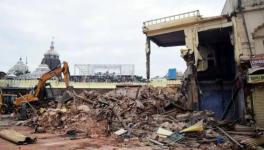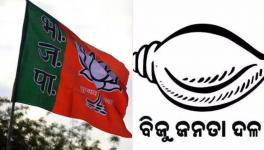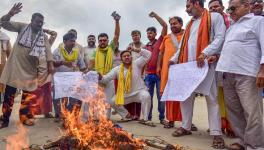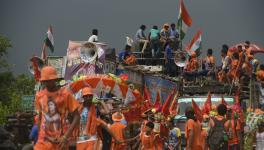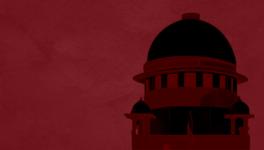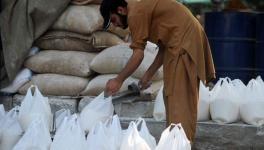Will Hanuman Jayanti Witness Similar Violence as Ram Navami Last Week? A Study of Violence on Both Festivals in 2022 Offers Lessons
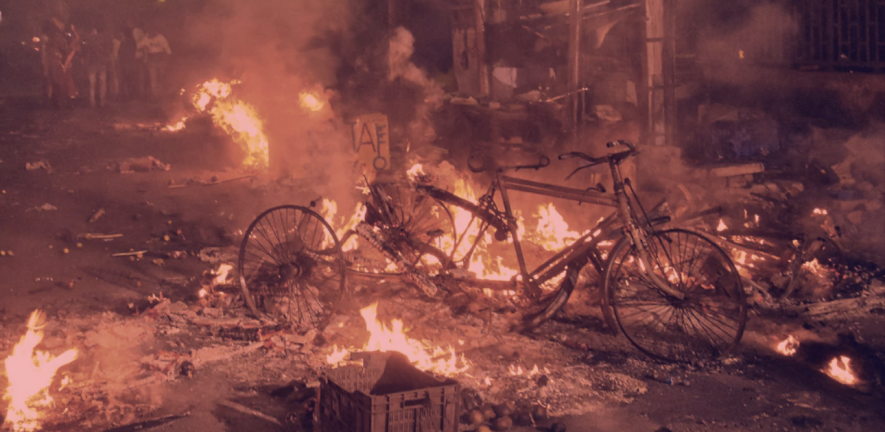
LAST week, on RAM Navami, there were communal clashes and violence across the country, most prominently in West Bengal, Maharashtra, Bihar, Gujarat, Karnataka and Uttar Pradesh. Two persons were reportedly killed in these violent clashes , one each in Karnataka and West Bengal.
This is the second year in a row that communal violence and strife on the occasion of Ram Navami, the Hindu festival that celebrates the birth of Lord Rama, has dominated the headlines, — although there has been an upsurge in Hindu–Muslim violence on the festival in recent years, coinciding with the birth and rise of the Bharatiya Janata Party (BJP)).
A recent report titled Routes of Wrath: Weaponising Religious Processions closely examines the communal violence in different parts of India during Ram Navami and Hanuman Jayanti (the Hindu festival that celebrates the birth of the Hindu deity Hanuman) in 2022. The report, published last month by a private group of citizens and lawyers, edited by senior advocate C.U. Singh and with a foreword by former Supreme Court judge Justice R.F. Nariman, provides piercing insight into what led to these incidents of violence last year, traces common patterns and modus operandi in such incidents across different states, and provides recommendations on what State agencies can do to prevent them.
Unfortunately, that the violence seen last week followed the same script and, in some cases, occurred in the same places as it did last year is an indictment of the State’s lack of preparedness and unwillingness to learn lessons from last year’s incidents of violence.
What does the report say?
The report documents the facts of the violence, death and destruction that occurred in April last year, mainly on and around Ram Navami on April 10 and Hanuman Jayanti on April 16 in Himmatnagar and Khambat in Gujarat; Lohardaga, Koderma and Bokaro in Jharkhand; Khargone and Sendhwa in Madya Pradesh; Jahangirpuri and the Jawaharlal Nehru University in Delhi; Karauli in Rajasthan; Mankhurd, Malad and Amravati in Maharashtra; Mormugao in Goa; and Bankura and Howrah in West Bengal. It further documents communal provocation and low-grade provocation that took place in various parts of Karnataka, Bihar and Andhra Pradesh around the same time.
It documents at least 100 people being injured across these states, as well as two deaths— one each in Jharkhand and Madhya Pradesh.
Routes of Wrath: Weaponising Religious Processions provides piercing insight into what led to these incidents of violence last year, traces common patterns and modus operandi in such incidents across different states, and provides recommendations on what State agencies can do to prevent them.
The report is based on secondary research derived from publicly available information, including the work of fact-finding initiatives, and reportage from credible news and information sources.
According to the report, there is a common template in all the incidents of communal violence that it documents: religious processions ostensibly celebrating Ram Navami and Hanuman Jayanti attacking Muslim-owned properties, businesses and places of worship in a targeted manner, on a large and seemingly coordinated scale that was unprecedented, leading to “major, life-changing losses for the victims in terms of their savings, documents of identity and proof of residence or ownership, and their means of livelihood”.
It notes that all such processions “comprised of larger-than-usual gatherings of saffron-clad men drawing swords, waving trishuls and even (in some cases) firearms, taking deliberately mapped paths that crossed major mosques and Muslim-dominated neighbourhoods, and raising provocative slogans about the coming of a Hindu Rashtra, the conditions under which Muslims would be allowed to live in this nation, and even justifying violence against Muslims. Many of these processions were accompanied by large flatbed trucks with concert-sized, high-decibel amplifiers and mega-speakers, on which DJs blasted hate-filled anti-Muslim music.”
As per the report, states that saw the most violence were those “where Hindutva groups and extremists enjoy the highest levels of political patronage.” It clearly brings out the direct and proximate role of the BJP and other organisations within the Sangh Parivar such as the religious organisation Vishwa Hindu Parishad (VHP), the Hindu nationalist militant organisation Bajrang Dal, and the Hindu activist group Hindu Jagran Manch, among others, in spreading communal unrest that led to the violence last year.
In the aftermath of the violence, State agencies further victimised Muslim families in riot-hit areas, leading to their displacement, either due to homelessness caused by unlawful demolitions, or by being forced to flee their homes out of fear of State harassment.
According to the report, despite the violent nature of the processions that were taken out during Ram Navami and Hanuman Jayanti, with armed participants raising provocative slogans, these were portrayed by the mainstream media and the Hindu Right as innocuous displays of religiosity, and never blamed for the violence that they caused.
Instead, the media, and politicians and commentators from the Hindu Right portrayed the pan-Indian streak of communal violence as instigated solely by Muslims who threw stones at the processions without provocation. On the other hand, the losses incurred by the victims, overwhelmingly Muslim, both due to mob violence and the State’s heavy-handed, arbitrary and unlawful response, was either erased or minimised in the media narrative.
The report notes that a crucial aspect of these processions’ strategy of inciting violence is that both Ram Navami and Hanuman Jayanti occurred last year during the holy month of Ramzan (as they do this year, too), which was used to provoke Muslims when they were present at mosques in large numbers in the mornings or evenings, as well as to paint Muslims uniformly as assailants in the popular discourse. This fed into the cycle of violence and the Islamophobic mood across the nation, further fomenting unrest.
It also looks at the success of Telangana, where the Police Chief and the High Court ensured that the processions on these days were carried out peacefully and harmoniously, without causing any disturbance to public order or provocation to any community.
Nature of instigation
The report notes that “[t]he processions concertedly targeted places of worship by gathering in front of mosques and chanting anti-Muslim slogans, either at the same time as namaz was being offered, or at the breaking of the fast after sunset, thereby ensuring that the confrontation would coincide with the largest possible number of Muslims being present and vulnerable.”
These processions played offensive music or chanted communally charged slogans that call for violence against non-Hindus, especially Muslims, in the vicinity of mosques or within Muslim localities, in order to provoke the Muslims.
The report makes the distressing point that incendiary, Islamophobic ‘Hindutva pop’ music, which has become a staple of Hindu religious processions in recent years, was reported to have been played at each one of the documented processions.
Tactics of mobilisation
The report provides insight into how the processions are the “most visible, visceral forms” of the efforts of the local branches of Hindu nationalist groups to assert Hindutva socio-cultural dominance at the cost of terrorising minorities, build an ethnostate, and homogenise the practices of Hinduism.
This is reflected in a religion-based polarisation replacing caste-based polarisation, which was the dominant political mobilisation strategy in Indian polity, as all caste groups are appealed to identify themselves as superior to non-Hindus. This is also reflected in the spike in the number of active Hindu-right wing organisations in several parts of the country, as well as in the rise in the use of economic boycotts against Muslims since 2018.
All the documented processions had participants armed with swords, tridents, bats and bricks, due to “the politicisation of Hindu festivals and their takeover by paramilitary groups operating with impunity due to State support.” Weapons distribution has been taking place openly in recent years, the report notes, especially in BJP-ruled states, as have been calls for mass violence and genocide against Muslims, in the form of dharma sansads and Hindu mahapanchayats.
All of this has created a communal powder-keg that manifests from time to time in the form of violence such as that seen in these processions. The report concludes that “incendiary processions have been used to play a multi-functional role in majoritarian consolidation. They are also masquerading as a popular but extremely dangerous mode of religious expression.”
Administrative response as collective punishment
According to the report, the study of the violence on Ram Navami and Hanuman Jayanti last year brings out the institutionalisation of the relationship between Hindutva outfits, and the police and district administration. This sustains “a violently undemocratic model of governance that is anathema to the rule of law.”
The undermining of State control over society and its authority over institutions in the manner manifest in these events is unprecedented, according to the report.
The report states that the indiscriminate use of bulldozers by the administration as punishment for the supposed obstruction of the processions is arbitrary and unconstitutional, since they violate three cardinal principles of the Constitution: presumption of innocence, rule of law, and the separation of powers among the three branches of the State.
The processions on Ram Navami and Hanuman Jayanti have come to comprise of larger-than-usual gatherings of saffron-clad men drawing swords, waving trishuls and even (in some cases) firearms, taking deliberately mapped paths that crossed major mosques and Muslim-dominated neighbourhoods.
It notes with concern the “largely passive role of the court”, and the long-term implications of illegality being ascribed to Muslim settlements. It also points out the absence of mandatory rehabilitation plans for the victims of the violence and the demolition drives that followed them, as well as the barriers to accessing any form of rehabilitation, when available, for the victims.
Such reprisals by the State, the report warns, are “important developments in the ongoing dismantling of rule of law and religious freedom in India” that further allow Hindutva hate groups to proceed with their agenda with impunity.
The report concludes that “India has reached a stage of perpetual violence… Facilitation and support for communal frenzy is being provided at all levels of the administration— from local police and administrative officials to the highest political levels in state and Central governments.”
Lessons from Telangana
In Telangana, some elementary precautions taken by the state administration and police authorities, endorsed and enforced by the Telangana High Court, resulted in huge Ram Navami processions being taken through Hyderabad and Bhainsa in absolute peace and harmony, without any unrest or violence.
This is impressive, considering that Hyderabad has a significant Muslim population (about 30 percent of the city’s population, and nearly 65 percent Hindus), and Bhainsa is a communal cauldron that has witnessed several Hindu–Muslim riots in the past.
How did Telangana achieve this?
To start off, different police commissioners across the state imposed strict limits on the Ram Navami Shobha Yatras that were proposed to be held on April 10 so as to avoid communal clashes. Processions were allowed to take only such routes that did not pass through communally sensitive areas, and organisations were not allowed to choose different routes. In Hyderabad, for that matter, a single route was delineated, to be followed by all processions, and proposals for alternative routes for shobha yatras were rejected.
At least three organisations whose applications for shobha yatras through routes of their choice were rejected filed writ petitions at the high court challenging the government’s refusal. These petitions were heard by a single-judge Bench of Justice Lalitha Kanneganti.
Justice Kanneganti passed a common order rejecting the pleas, and specifying in unambiguous terms the permitted routes for shobha yatras in Hyderabad and Bhainsa. She refused to let the petitioner organisations deviate from the routes and conditions for the processions set by the police.
Telangana’s handling of the religious processions showed that religious processions can be carried out without communal clashes or riots, as indeed the vast majority in India have, if the administration and the courts are willing to ensure so.
What are the parallels to the violence seen last week?
The violence witnessed on Ram Navami last week regrettably followed the same pattern as that meticulously deconstructed by the report: processions carried out in Muslim-majority neighbourhoods, loud and vile music played right outside mosques, and deviation from approved routes.
Two illustrative examples of incidents of violence last week that almost exactly replicated the violence that occurred in those areas on Ram Navami last year epitomise the failure of the State to learn from last year’s failure, and indicate that the administration was at best indifferent and at worst interested or even involved in the repetition of violence.
Howrah
First, in the PM Basti area of Howrah, West Bengal, ten people, including police officials were injured, public property vandalised, stones pelted, and police vehicles were set on fire on Ram Navami last year, according to the report. The report explains that the violence allegedly erupted due to a provocative speech in the primarily Muslim neighbourhood by a VHP procession that contained armed participants.
Last week as well, 15 people were injured, property was damaged and vehicles were burnt in violence that erupted in PM Basti due to a VHP procession in the area on Ram Navami.
At present, there are conflicting versions of material facts doing the rounds as to who provoked the violence, whether the participants in the procession were carrying weapons, and whether the procession had been permitted to enter the area as part of its approved route, as well as questions over police inaction. However, after last year’s violence, why did the state administration not ensure that no VHP procession enters the PM Basti area?
Malad
Similarly, violence occurred on Ram Navami last week in Malad in Maharashtra that mirrored the violence that occurred there on Ram Navami last year.
The report details that on April 9 last year, a Bajrang Dal-organised procession played loud music near the Jama Masjid in Malad, and later in the evening raised religious slogans and played loud music near the Hazrat Masjid there just as Muslims observing Ramzan were beginning to break their fast and maghrib (evening) prayers were starting. This led to clashes between the two groups.
Last week, clashes occurred in Malad after a 6,000-person strong procession reportedly organised by the Bajrang Dal, the VHP and other Hindu organisations played loud music near the Jama Masjid when namaz was going on in the mosque. This led to some Muslims pelting stones at the procession, and clashes between the two groups.
According to a report by Hindustan Times, first information reports have been registered against 12 men, all of whom are Muslims, as well as 400 unidentified persons, for allegedly rioting, assaulting and unlawfully assembling during the Ram Navami procession. The report doesn’t refer to any police action against the act of provocation by the procession members, or even mention the facts of the provocation that led to the stone-pelting.
Again, after last year’s violence, why did the state administration not take any proactive steps to prevent the story from virtually repeating itself?
Any sane and functioning government that cares for the welfare of its people and the secular fabric of the nation would have taken note of the repetitive patterns of violence since last year, and dedicated itself towards preventing this from recurring.
In Telangana, processions were allowed to take only such routes that did not pass through communally sensitive areas, and organisations were not allowed to choose different routes. In Hyderabad, a single route was delineated, to be followed by all processions, and proposals for alternative routes for shobha yatras were rejected.
As the report has shown with Telangana’s example, such violence can be prevented with common sense, minimal measures that are robustly enforced.
It is hoped that governments take the example of Telangana, and pay heed to lessons from the report, to prevent similar violence on Hanuman Jayanti tomorrow. However, the insights of the report indicate that similar violence will almost certainly occur across the nation.
What are the related proceedings initiated at the Calcutta High Court?
The Calcutta High Court on Monday heard a public interest litigation filed by politician Suvendu Adhikari, who is the current Leader of the Opposition in the West Bengal Legislative Assembly, and expressed its concern over the spate of violence that took place on Ram Navami at various places in the state.
During the hearing, it was submitted that in the Shibpur, Rishra and Ramtala areas under the Shibpur Police Station of Howrah witnessed several rallies on Ram Navami that were organised by right-wing groups. During the processions, bombs and stones were allegedly hurled.
The state government, in order to curb the spread of violence, has also suspended internet services in the affected districts of Howrah and Hooghly surrounding Kolkata, the court was informed.
Expressing its concern, the Bench comprising the Acting Chief Justice T.S. Sivagnanam and Justice Hiranmay Bhattacharyya asked, “Is there any report? Any case has been registered? Any arrest?” In response, advocate Soumya Majumdar, counsel for the petitioner Adhikari, stated that 36 persons had been arrested, and the statements of ten persons had been recorded under Section 161 (examination of witnesses by police) of Code of the Criminal Procedure (CrPC).
Advocate General of West Bengal Soumendra Nath Mookherjee submitted that there was no violation of law on the part of those who organised the procession. The attack, he submitted, was done on a procession that had prior sanction of the police.
Advocate Sabyasachi Chatterjee, representing an intervener, argued before the court that “the procession took place allegedly with firearms. What is the stand of the State? What prevented the police from imposing [an order under Section 144 (power to issue order in urgent cases of nuisance or apprehended danger) of the CrPC] and restoring law and order?” He also argued that the procession in question took place just so that a particular political party gets political benefit from such acts.
After hearing the submissions, the Bench asked the respondent state government that CCTV footage as well as video footage that are circulating on social media be placed before it. It also directed that the safety of school children and businesspersons should be ensured, and there should be adequate deployment of police forces to ensure restoration of normalcy.
The Bench directed the parties to appear before it on the next date of hearing, which was set as April 6.
(We are grateful to Imtiaz Akhtar, advocate at the Calcutta High Court and joint editor of the Calcutta Law Journal for contributing the last section on the proceedings at the Calcutta High Court.)
Get the latest reports & analysis with people's perspective on Protests, movements & deep analytical videos, discussions of the current affairs in your Telegram app. Subscribe to NewsClick's Telegram channel & get Real-Time updates on stories, as they get published on our website.










